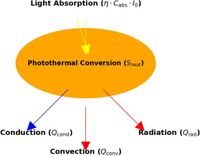Optimizing Gold Nanorods for Enhanced Photothermal Applications
Researchers are leveraging the unique properties of gold nanorods to optimize their efficiency in converting light into heat, a process crucial for sustainable energy and medical applications.
Noble metallic nanoparticles (NPs) like gold nanorods (AuNRs) have emerged as pivotal materials in the realm of sustainable energy, especially in solar energy conversion and biomedical applications. With their size-dependent optical and electrical characteristics, these nanoparticles present a double-edged opportunity for innovation, providing solutions in both energy and healthcare.
A recent study published highlights the optimization of AuNRs by focusing on their shape and size to enhance light-to-heat conversion capabilities. Utilizing the Differential Evolution (DE) algorithm, a sophisticated optimization technique, the researchers calculated the ideal dimensions of AuNRs for varying wavelengths, thereby emphasizing the importance of aspect ratio (AR) in maximizing the efficiency of these nanoparticles.
The research findings demonstrate that near-spherical AuNRs, with an AR of 0.71 and 0.75, perform best at shorter wavelengths, while elongated AuNRs, with an AR of 0.24 and 0.17, outperform others in the longer wavelength range. This nuanced understanding of particle shape and light interaction is paramount for developing efficient photothermal materials suitable for a wide array of applications.
Moreover, the study conducted Computational Fluid Dynamics (CFD) calculations to simulate real-world scenarios of heat generation under laser irradiation conditions. A practical example involved embedding AuNRs in borosilicate glass while exposing them to lasers of varying wavelengths. The results indicated a marked increase in temperature generation attributed to the optimized design of the nanoparticles.
At the wavelength of 465 nm, temperature rose from 2.28 to 39.08 °C, while at 532 nm, it elevated from 1.91 to 81.42 °C. Such increases underline the efficacy of tailored AuNRs in enhancing heat generation compared to standard experimental samples, which typically produce less impressive outcomes.
These advancements hold significant promise, particularly in the context of renewable energy solutions and medical treatments. Innovations in photothermal therapy leverage the ability of AuNRs to convert light into heat, enabling targeted cancer treatments that minimize damage to surrounding healthy tissues. The application extends beyond oncology; researchers are exploring the use of photoactivated nanoparticles for accelerating wound healing and combating antibiotic-resistant bacteria.
The findings reflect ongoing research interests in optimizing nanomaterials for improved performance across numerous fields. As the quest for efficient expansive energy solutions continues, optimizing the characteristics of nanomaterials like AuNRs plays a crucial role in the advancement of clean energy technologies and medical therapies.
This ambitious investigation, as revealed by the authors of the article, marks a significant contribution to the fields of nanotechnology and energy conversion, effectively bridging theoretical groundwork with practical applications.
Future studies will undoubtedly focus on the experimental fabrication of these optimized AuNRs to validate the theoretical frameworks developed, with an eye toward integrating these materials within advanced photothermal systems. As the technology matures, the prospects for enhanced photothermal materials appear boundless.




